Push, Pull, Legs Program: Simple Regimen to Build Muscle
There’s a lot of chatter in the fitness world about what constitutes a great workout. Some folks want to drop their average body fat percentage and follow a celebrity routine like the Brad Pitt Fight Club workout or Daniel Craig workout for the James Bond franchise. Others just want to stick to a pragmatic program. If you’re in the latter camp, a push, pull, legs split is for you.
Whether you’re a novice and seeking weight lifting for beginners or an advanced lifter who’s been training for decades, take the guesswork out of the equation by using a simplified training regimen.
We’re covering everything you need to know about a push, pull, legs split. It’ll yield dividends in the long run for your body and sanity.
What Is a Push, Pull, Legs Program?
A push, pull, legs program is as simple as it sounds. It’s a full-body functional workout split that allows you to train multiple muscle groups based on their function or proximity to the body. Each group is featured in its own workout and is the only resistance training to be performed on that day. On three separate days, you’ll train your upper-body push muscles (e.g. bench press), you’re upper-body pull muscles (e.g. barbell rows), and legs.
The chest, shoulders, and triceps are all muscle groups that assist in pushing or pressing. Thus, they’re grouped together. The same applies to the back, rear delts, traps, and biceps on a pull workout. Last, but not least, are the legs, which include the quads, hamstrings, glutes, and calves. The abs, or core, are usually grouped together with the legs. However, you can train them with the upper body or on their own if you prefer.
Below, see different ways you can schedule a push, pull, legs split depending on your fitness level. Beginners will follow the most basic push, pull, legs 3 day split while intermediate and advanced lifters will tackle more days, more exercises, and more volume.
Related: Best Full-Body Workout to Shed Fat and Gain Muscle
How to Schedule a Push, Pull, Legs Split
Training a push, pull, legs 3 day split provides several scheduling options for individuals who lack time. Whether you’re a parent who struggles to find time to work out or your workload keeps you busy, a push, pull, legs routine makes scheduling your workouts simple.
Beginner Push, Pull, Legs Routine
With this straightforward routine, you can simply train every other day to allow your body enough rest between workouts. A very popular schedule that is easy to follow is below.
- Monday: Push Day
- Tuesday: Rest
- Wednesday: Pull Day
- Thursday: Rest
- Friday: Legs
- Saturday and Sunday: Rest
Intermediate Push, Pull, Legs Routine
If you are at an intermediate level of training and feel like you want to take your training to the next level, you could take the schedule above and add more workouts, training two days on and one day off. This would mean you train in a different order every week, but you are getting in more volume, which could be beneficial for strength gains. If you were to track your workouts, it may look like the push, pull, leg routine below:
- Day 1: Push
- Day 2: Pull
- Day 3: Rest
- Day 4: Legs
- Day 5: Push
- Day 6: Rest
- Day 7: Pull
- Day 8: Legs, etc.
Advanced Push, Pull, Legs Routine
Advanced trainees could go as far as to train three days in a row before taking a day or two off. This should be reserved for athletes and lifters with at least a year of hard training under their belts and extra attention paid to recovery.
- Day 1: Push
- Day 2: Pull
- Day 3: Legs
- Day 4 and 5: Rest
Related: How to Use Lifting Straps, a Powerlifter’s Favorite Accessory
Benefits of a Push, Pull, Legs Split
There are several reasons to follow a push, pull, legs routine. First and foremost is its simplicity. Grouping the workouts in this manner makes it easier to follow, and you can be assured that you’re training everything with the necessary intensity and volume required for growth and strength improvement. Unlike the body-part splits where you’re training individual muscle groups, a push, pull, legs routine allows you to hit multiple muscles at once.
Let’s look at the push day as an example. While you might think pushing movements like the bench press mainly works the chest, other muscles such as the shoulders and triceps are indirectly involved, too. So, once you finish the compound movement you can go right into doing shoulder and triceps exercises. The same theory applies to the pull workout and leg day.
Not only are you hitting multiple muscle groups, but this routine also allows for optimal recovery time. Plus, if you have a hectic schedule, only training your body three days a week (at least to start) can make your life a whole lot easier.
The Best Push, Pull, Legs Routine
The workouts below include working sets only. Before you begin, make sure you’re performing at least two warmup sets of the first exercise and one of each exercise after with lighter weights. As you work through this program week by week, you should aim to get one more rep than the previous session or add weight if you max out the reps for all sets with the weight you chose.
For example, if you manage to complete 3 working sets of 5 reps with the same weight, then you should increase the weight the following workout. If you fail to get 3 sets of 3 reps, then you should use less weight next time. If you’re in the rep range, try to achieve at least one more rep the next time you perform that workout.
This workout focuses on physique improvement as well as strength gains. The workouts should take approximately one hour to complete if you rest 1 to 2 minutes between each set. If you have the time and feel you need more rest on the heavier sets, take it. If you need to substitute an exercise because of a personal issue or lack of equipment, make sure you choose an exercise that performs a similar function. (Example: Arnold press instead of seated shoulder press machine.)
Related: Best Landmine Exercises to Raise the Bar on Strength Workouts
Workout A: Push
Incline Barbell Bench Press
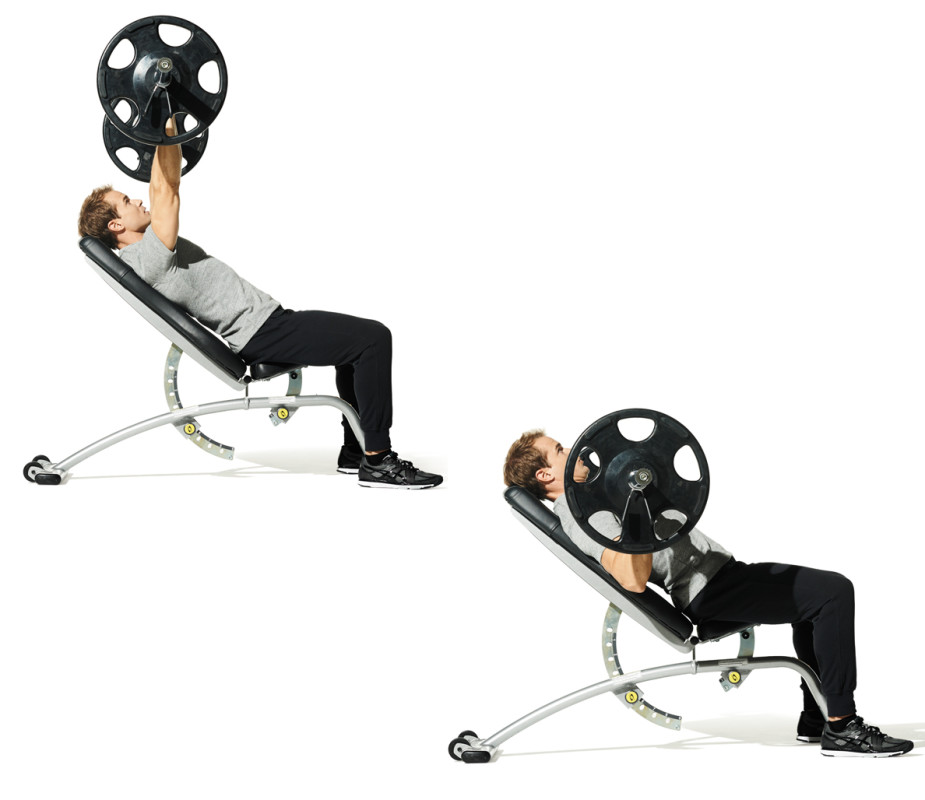
James Michelfelder
How to Do It
- Lie back on an incline bench and grasp the bar with hands slightly wider than shoulder-width apart, to start.
- Arch your back and pull the bar out of the rack.
- Lower the bar to the upper part of your chest, stopping a few inches above it.
- Then drive your feet into the floor as you press the bar back up.
- That’s 1 rep.
- Perform 3 sets of 3 to 5 reps.
Flat Dumbbell Bench Press
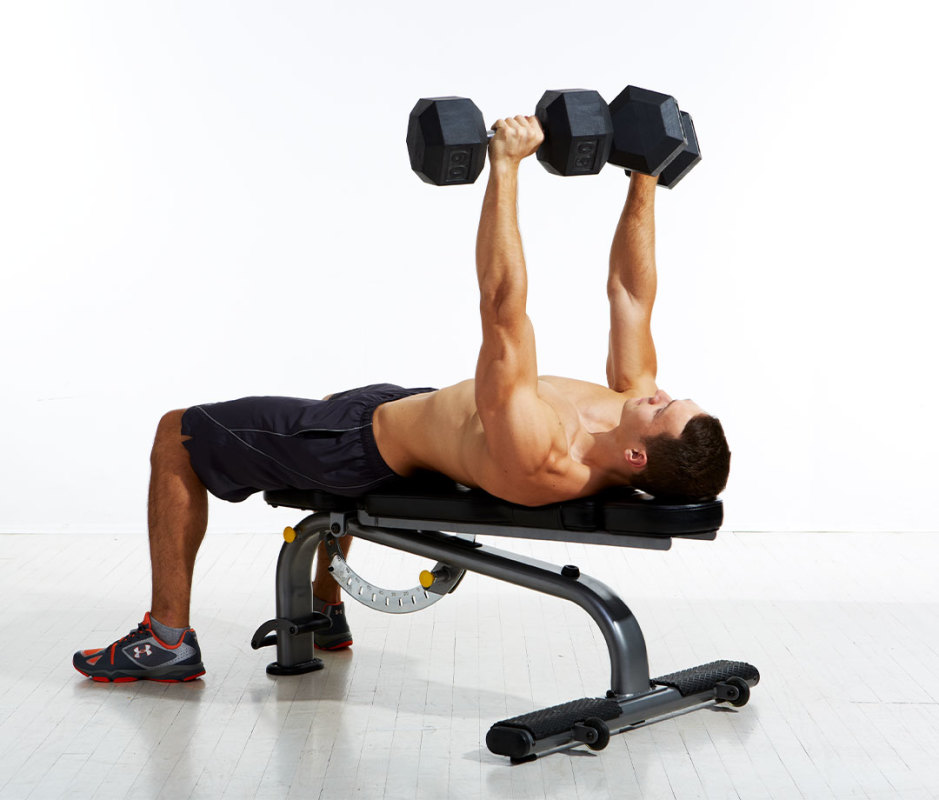
Beth Bischoff
How to Do It
- To start, lie back on a flat bench with a dumbbell in each hand, resting them on your chest.
- Plant your feet firmly, arch your back, and tighten your glutes and abs.
- Push your feet into the floor as you press the barbells up.
- Complete 3 sets of 6 to 8 reps.
Seated Shoulder Press Machine
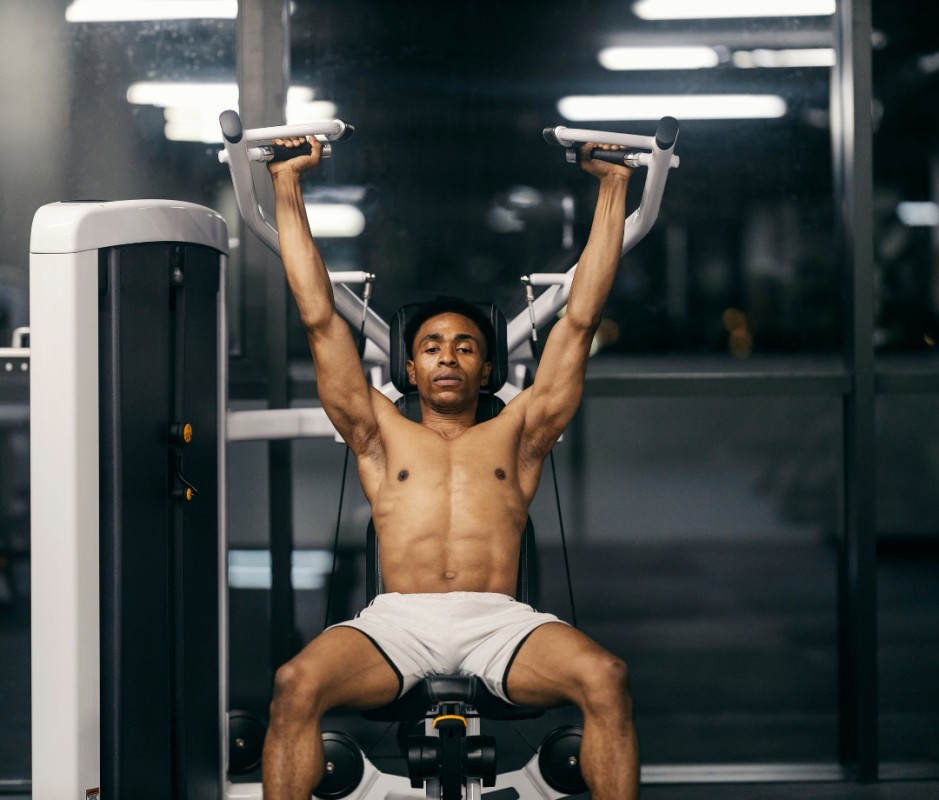
Getty Images/dusanpetkovic
How to Do It
- To start, sit in a seated position in the seated shoulder press machine with the handles set about shoulder height.
- Grab the handles with a pronated or neutral grip.
- Inhale, brace your core and press the weight directly overhead.
- Slowly lower the handles back to the starting position.
- That’s 1 rep.
- Perform 3 sets of 6 to 8 reps.
Lateral Raise
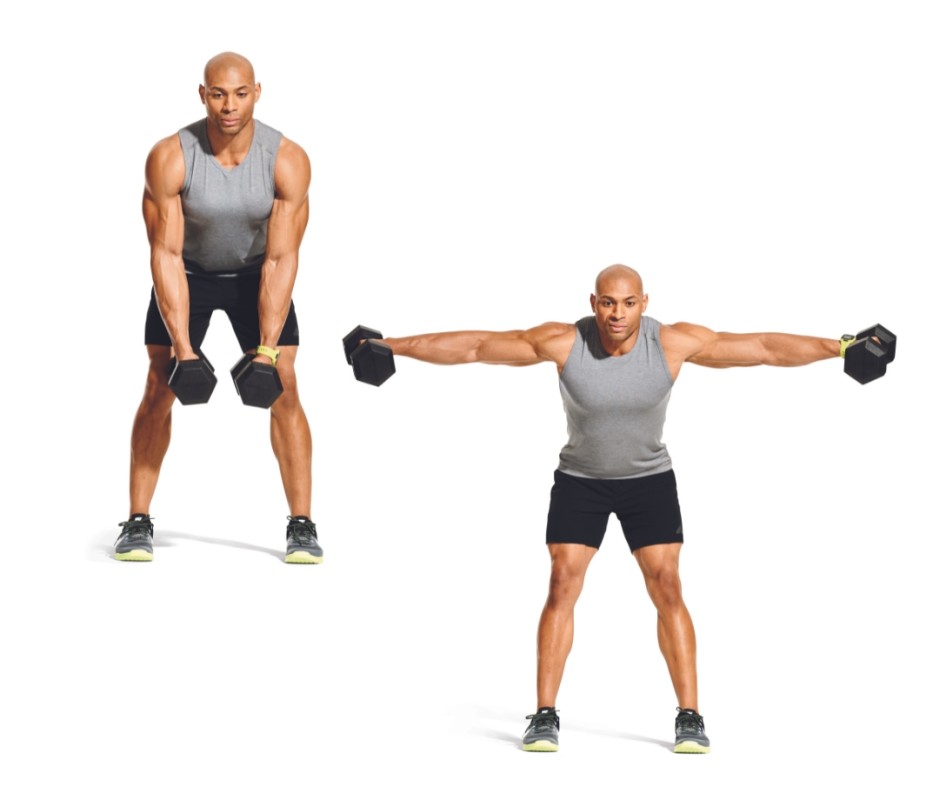
James Michelfelder
How to Do It
- To start, standing holding a dumbbell in each hand.
- Raise the dumbbells out to your sides, just above 90 degrees before bringing your arms back down to the starting position.
- That’s 1 rep.
- Perform 3 sets of 8 to 10 reps.
Single-Arm Overhead Triceps Extension
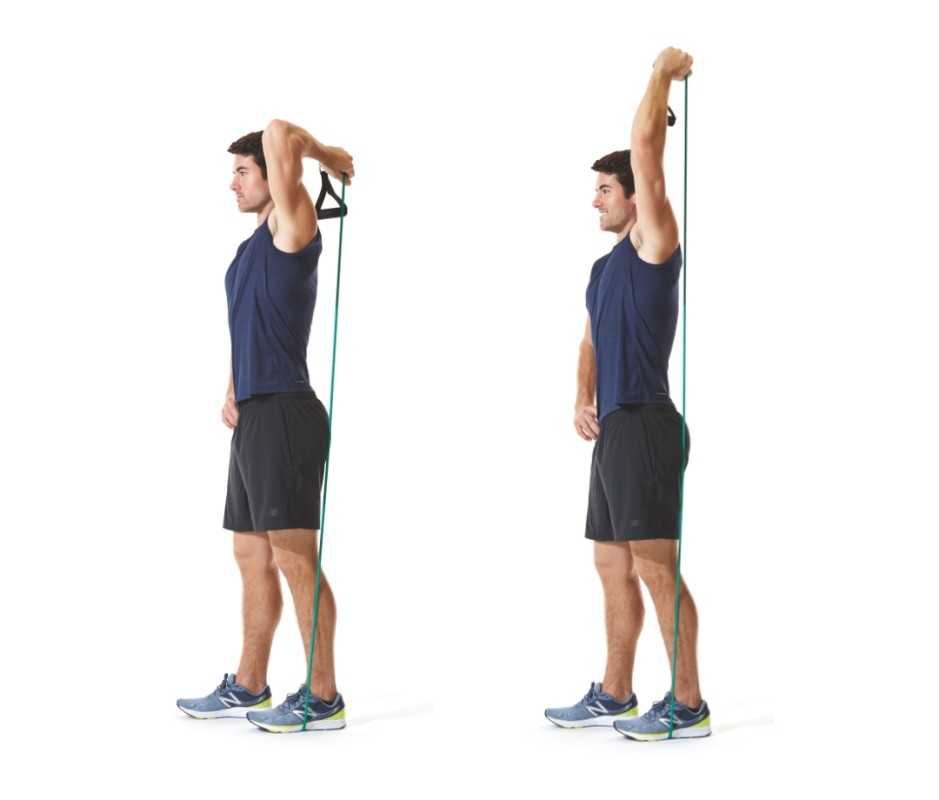
Jay Sullivan
How to Do It
- To start, sit on a flat bench with a dumbbell in one hand.
- Bend the arm with the dumbbell behind your head.
- Squeeze your triceps and straighten your arm until the dumbbell is over your head.
- Pause at the top with your elbow straight, and then slowly your arm back to the starting position.
- Complete 3 sets of 8 to 10 reps with each arm.
Rope Pressdown
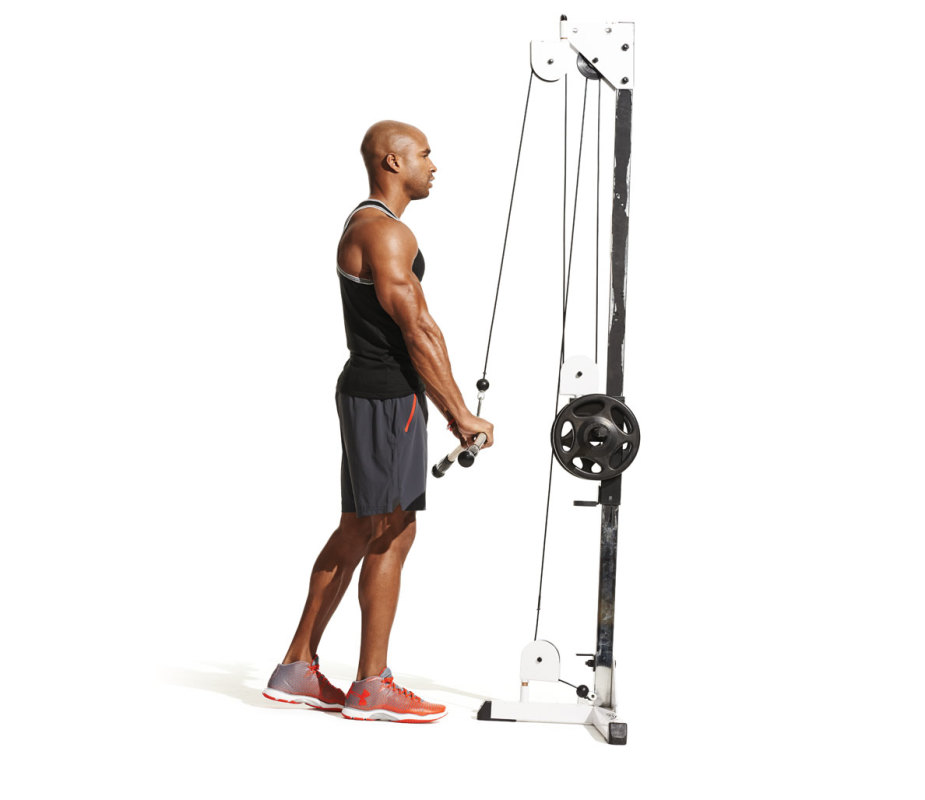
James Michelfelder
How to Do It
- Attach a rope handle to the top pulley of a cable station and grasp an end in each hand.
- Keeping your upper arms by your sides, extend your elbows, and hold the end position for a second.
- That’s 1 rep.
- Perform 3 sets of 8 to 10 reps.
Workout B: Pull
Barbell Row
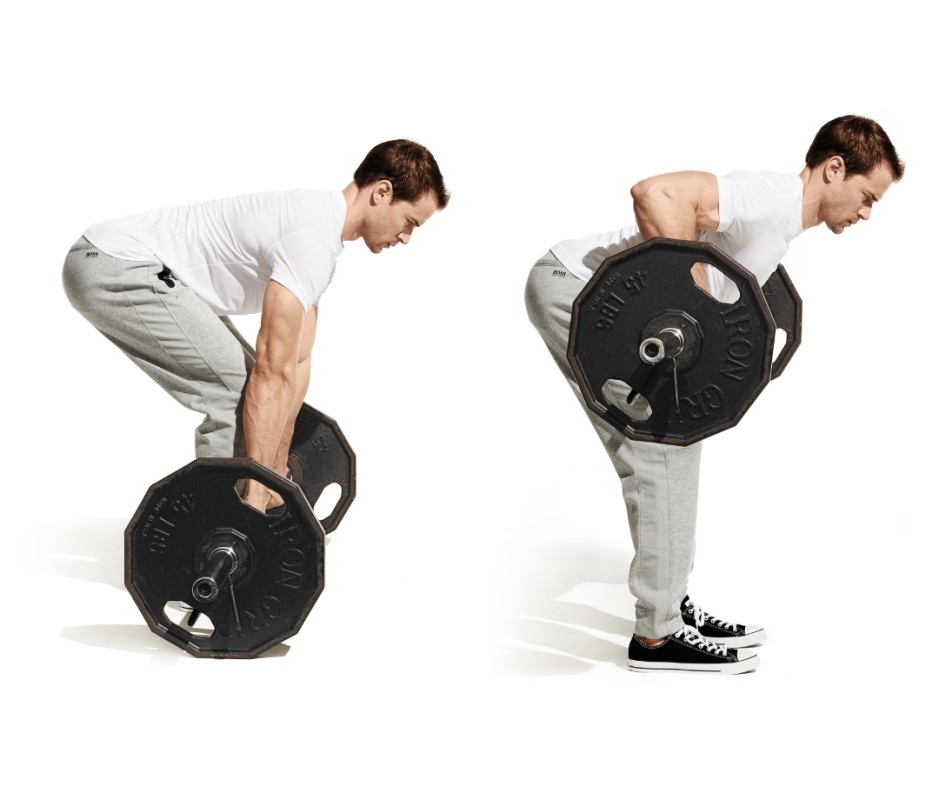
James Michelfelder and Therese Sommerseth
How to Do it
- Grasp a bar with an overhand grip, hands shoulder-width apart, and let it hang in front of your thighs, to start.
- Bend at the hips and lower your torso until it’s parallel to the floor.
- Bend your knees a bit to take tension off your hamstrings.
- Squeeze your shoulder blades together and row the bar to meet your stomach before slowly bringing it back down.
- That’s 1 rep.
- Perform 3 sets of 3 to 5 reps.
Dumbbell Pullover
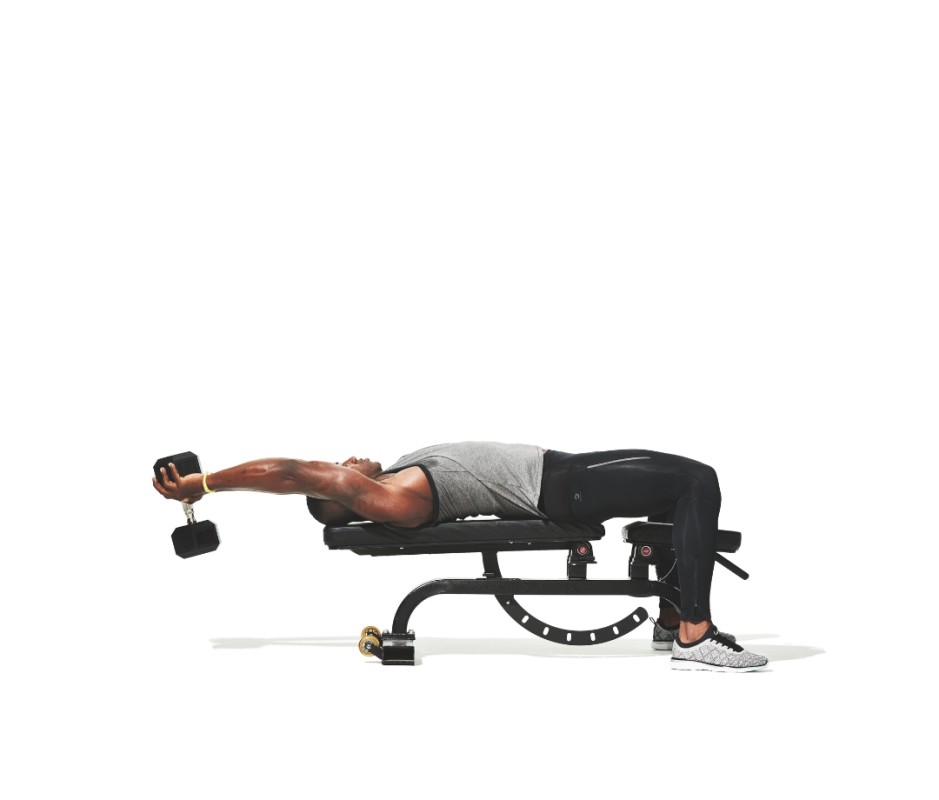
James Michelfelder
How to Do It
- To start, lie on the length of a flat bench with feet on the floor, shoulder-width apart, holding the “bell” of a dumbbell by creating a diamond between thumbs and index fingers.
- Extend arms directly over the chest, palms facing the ceiling, wrists in line with shoulders.
- Keeping arms straight, inhale as you lower the dumbbell back toward the front of the bench until your biceps are aligned with your ears.
- Exhale and engage lats to bring the dumbbell back to the start position.
- That’s 1 rep.
- Complete 3 sets of 6 to 8 reps.
Dumbbell Shrugs
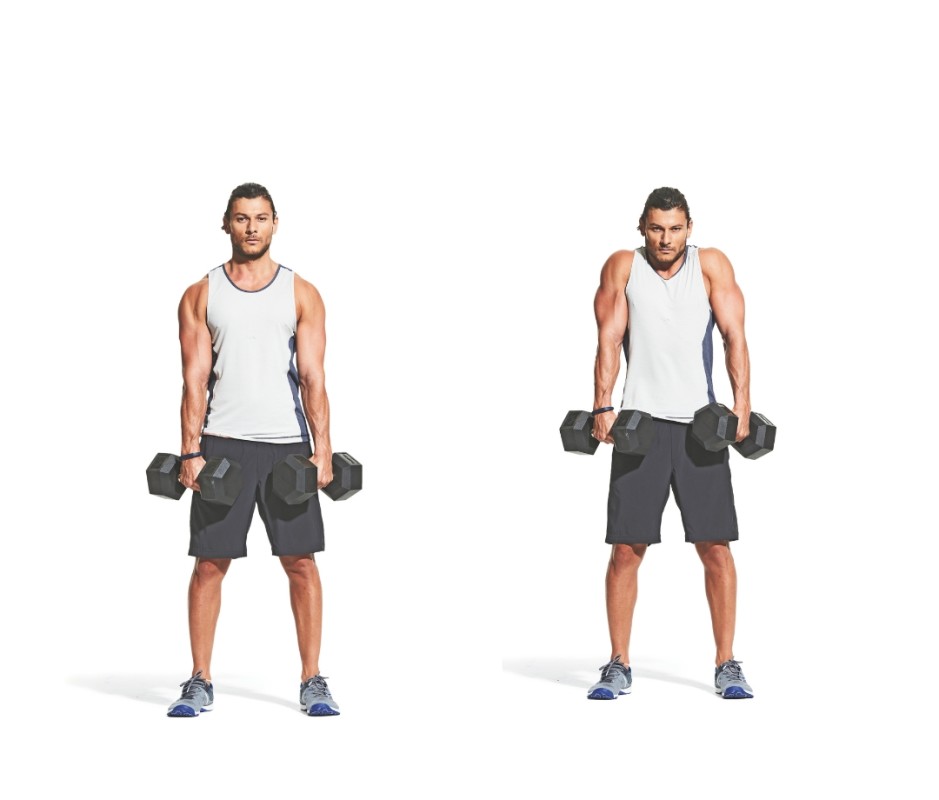
James Michelfelder
How to Do It
- To start, hold a dumbbell in each hand at your sides.
- Shrug your shoulders as high as you can before bringing your arms back down.
- Perform 3 sets of 6 to 8 reps.
Machine Reverse Flyes
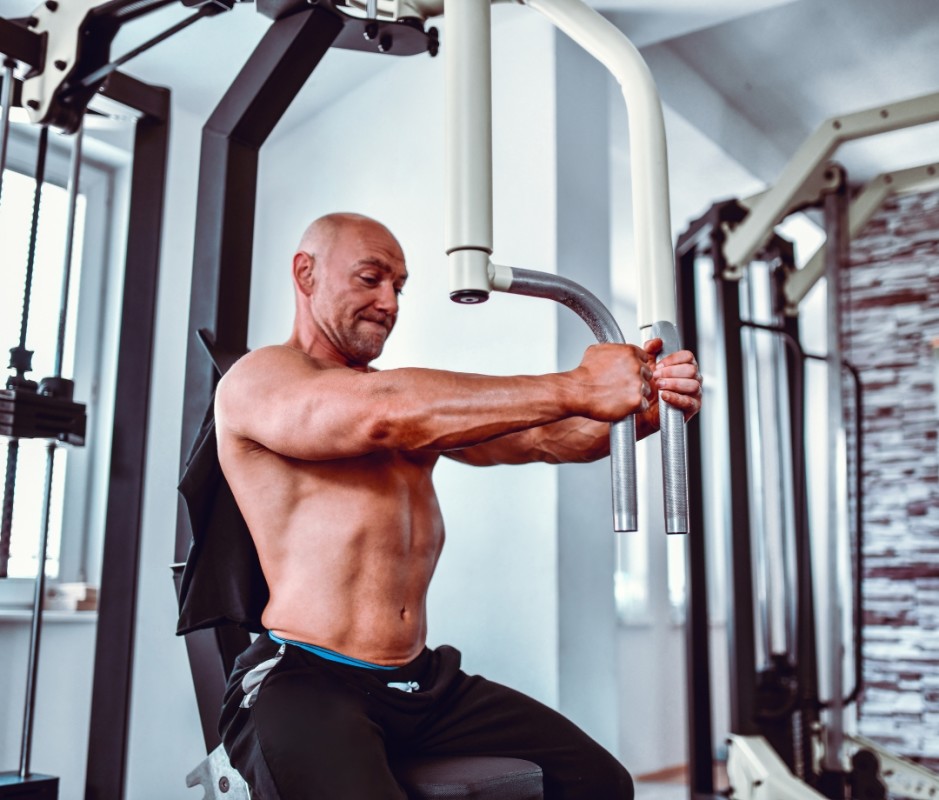
Getty Images/AleksandarGeorgiev
How to Do It
- To start, sit on a pec deck machine facing towards it.
- Adjust the handles so that your arms are in front of you.
- Press your chest against the seatback and plant your feet firmly on the ground.
- Grip the handles with an overhand or neutral grip.
- Pull your arms out and away until your arms are out at your sides.
- Squeeze your rear delts at the back of the movement, then slowly return to the starting position.
- That’s 1 rep.
- Complete 3 sets of 8 to 10 reps.
Barbell or EZ-Bar Curl
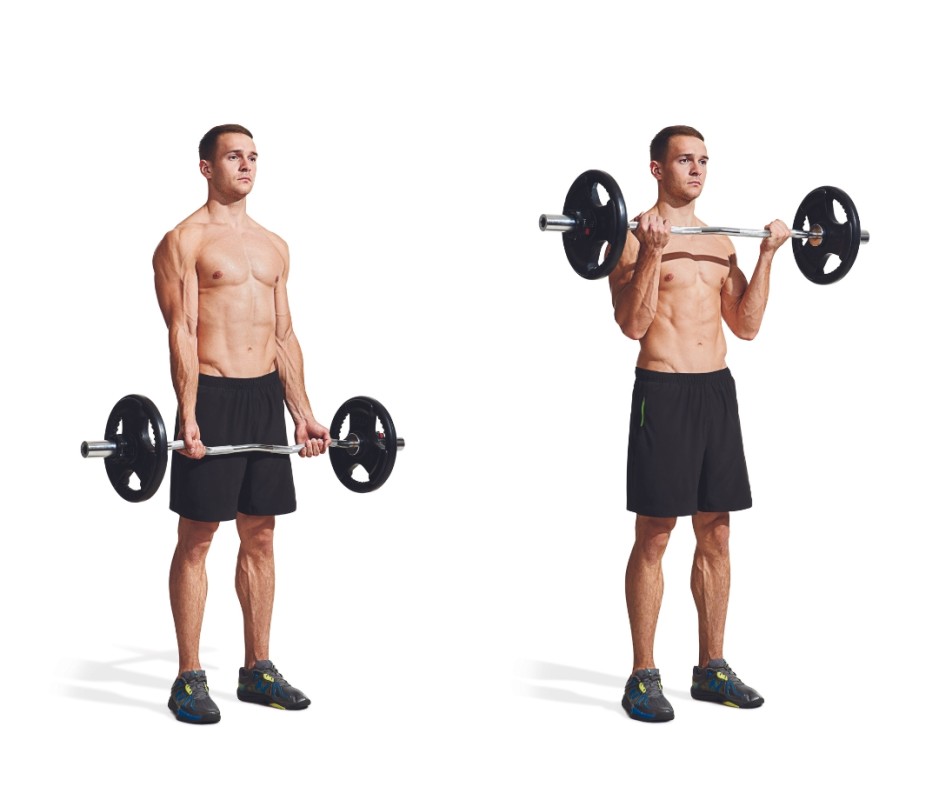
Beth Bischoff
How to Do It
- Grasp an EZ-bar with hands shoulder-width apart, to start.
- Keeping your upper arms stationary, curl the bar up towards your face stopping at your chest.
- Perform 3 sets of 8 to 10 reps.
Seated Hammer Curl
James Michelfelder 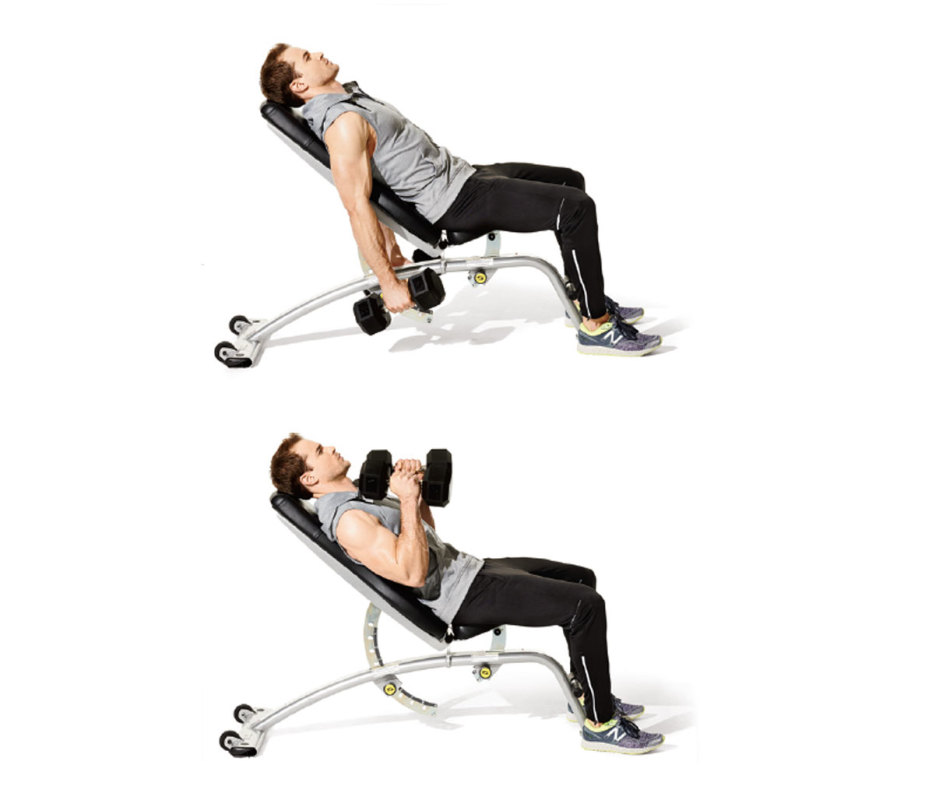
How to Do It
To start, adjust a bench to 90 degrees and sit down with dumbbells in each hand with a neutral grip. Curl the dumbbells straight up to your shoulders. Squeeze your biceps hard at the top before lowering the weight back to the starting position. Complete 3 sets of 8 to 10 reps.
Related: This Is Our Trainer’s Favorite Routine for a Bigger, Stronger Back
Workout C: Legs
Barbell Back Squat
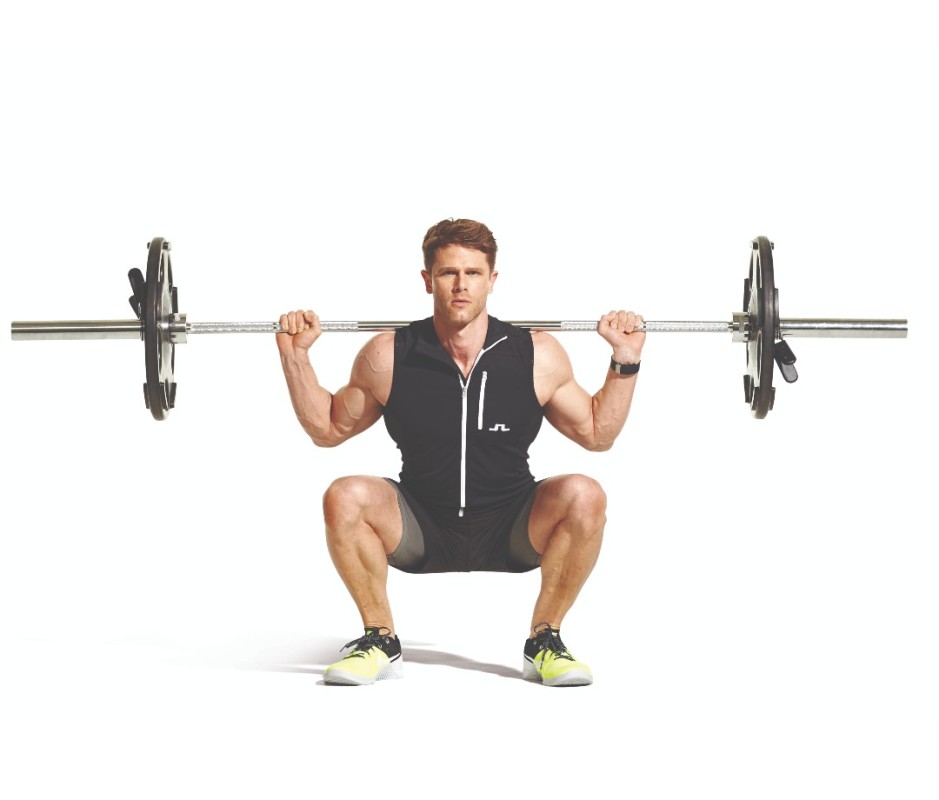
James Michelfelder
How to Do It
- In a squat rack step under the barbell and place it high on your trap muscle across the top of your shoulders, to start.
- Place your hands a few inches outside shoulder-width to keep the bar stable.
- Step back and stand with your feet shoulder-width apart and toes turned slightly outward.
- Take a deep breath then bend your hips and knees to lower your body as if you were going to sit down in a chair.
- Aim for your butt to go lower than knee level while maintaining a tall, upright posture with your upper body.
- Extend your hips to come back up, continuing to push your knees outward.
- Perform 3 sets of 3 to 5 reps.
Stiff Leg Deadlift
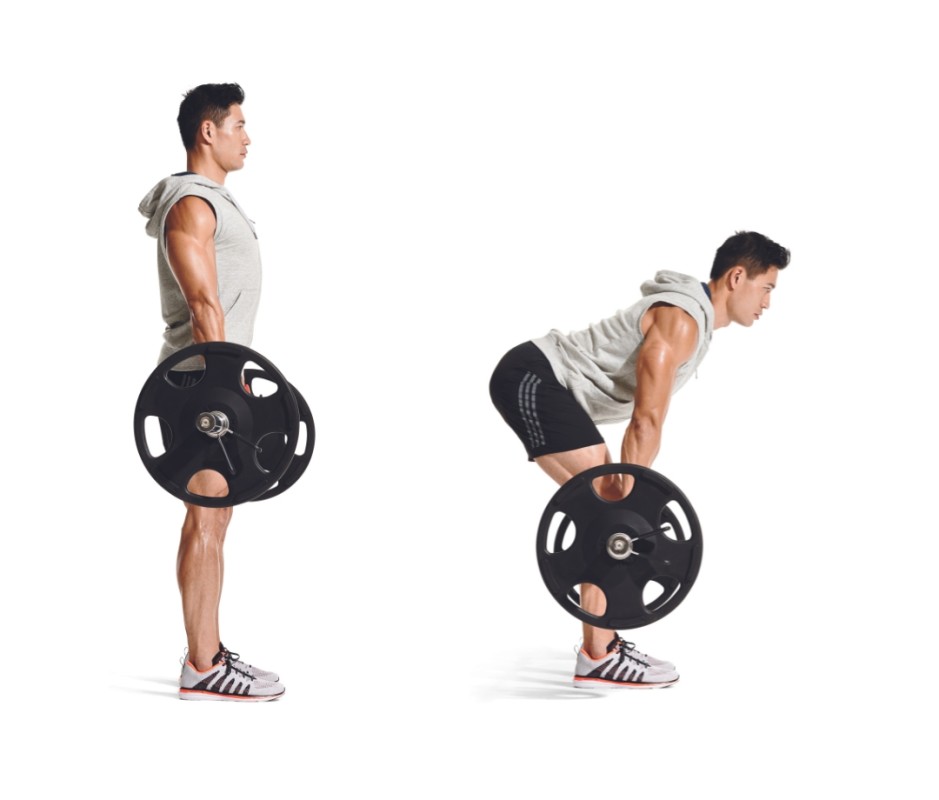
James Michelfelder
How to Do It
- To start, grasp a barbell with hands about shoulder-width apart.
- Slowly lower the bar toward the floor while maintaining a natural arch in your back.
- Finish the move with the bar just above the floor, then squeeze your glutes and hamstrings to come back up.
- Complete 3 sets of 6 to 8 reps.
Leg Press
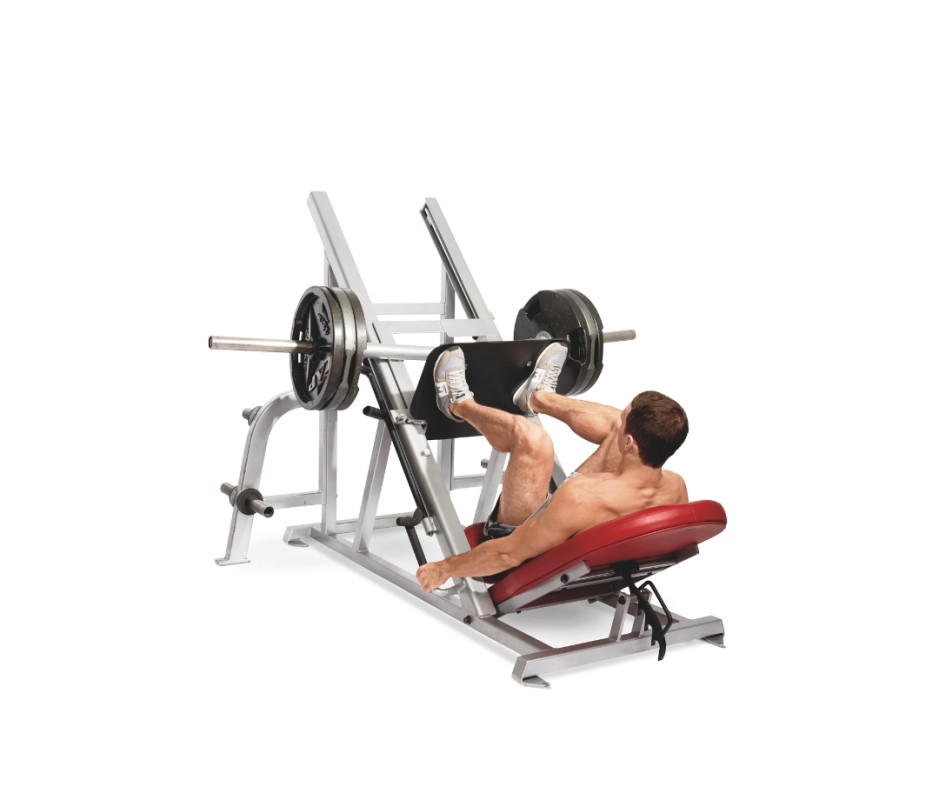
Beth Bischoff
How to Do It
- To start, lie in a leg press machine.
- Place your feet flat on the foot place, brace your core, and push the platform away from your body.
- Exhale and extend your legs until they are almost straight. Don’t lock out your knees.
- Pause at the top and return to the starting position by gradually bending the knees.
- Perform 3 sets of 10 to 12 reps.
Seated Hamstring Curl
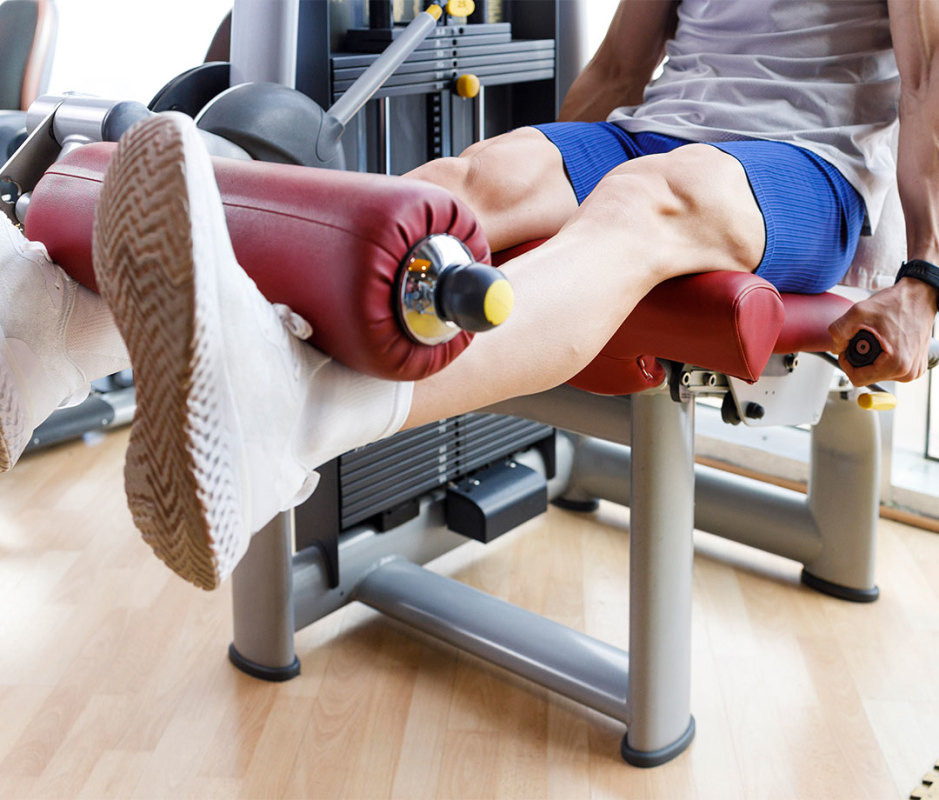
Getty Images/Westend61
How to Do It
- To start, set up on a leg curl machine and make sure your knees are aligned with the axis of rotation.
- Curl the weight until your hamstrings are fully contracted before slowly lowering your legs back to the starting position.
- Complete 3 sets of 10 to 12 reps.
Seated Calf Raise
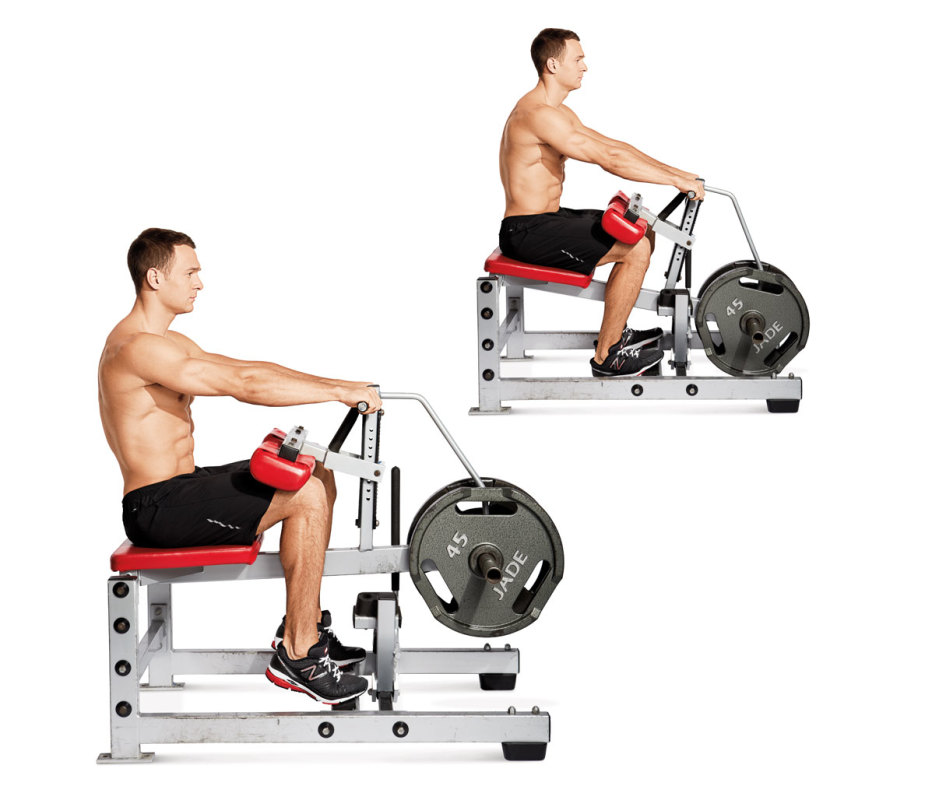
Beth Bischoff
How to Do It
To start, sit on a seated calf raise machine or on a bench with your feet on a block or step and dumbbells on your thighs. Allow your heels to sink toward the floor so you feel a stretch on your calves and then press them up. That’s 1 rep. Perform 3 sets of 10 to 12 reps.
Calf Press
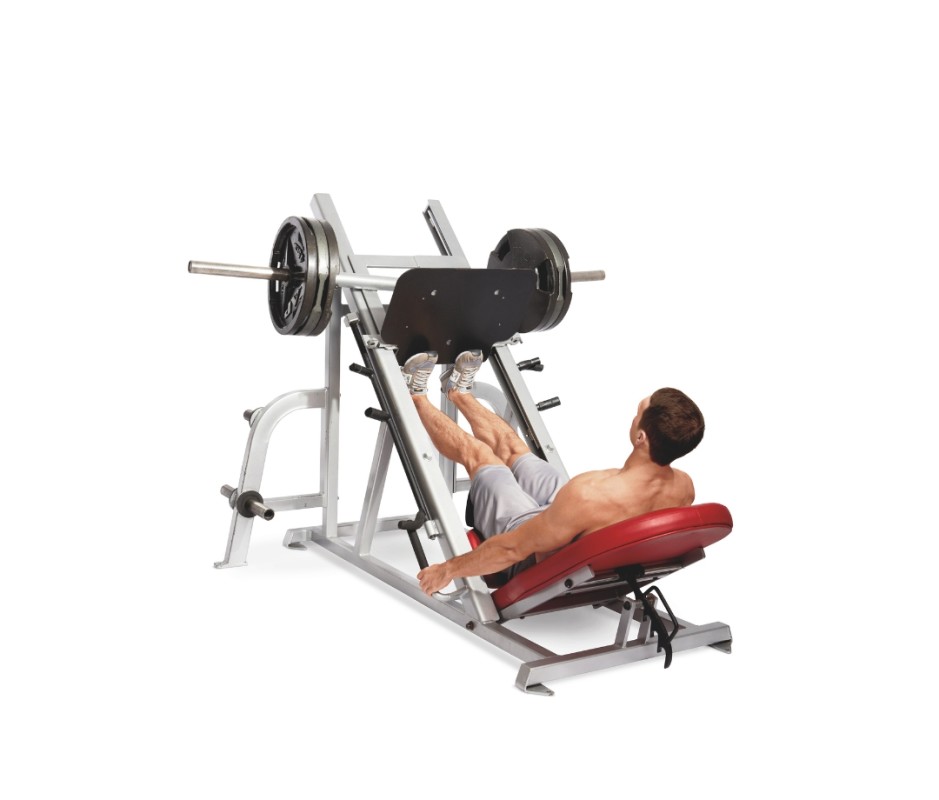
Beth Bischoff
How to Do It
- Start by sitting on a leg press machine with your legs straight out in front of you and feet on the platform shoulder-width apart.
- Place your toes and the balls of your feet on the platform with your heels extending off the bottom.
- Lower the safety bars and press on the platform extending your ankles and flexing your calf.
- Go back slowly to the starting position.
- Repeat for 3 sets of 10 to 12 reps.
*Perform one ab exercise of your choice for 3 sets of 15 reps on each workout day.
If you wish to do cardio to either stay lean or focus on weight loss, perform this session separately from the weight training session or after you complete the weight training if it must be in one session.
Related: What Zone 2 Heart Rate Is and How to Calculate Yours

